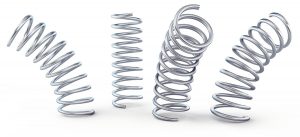Hardness, Density, or Compression?

If you see someone measuring a foam mounting tape with a durometer gauge or have done so yourself in order to measure hardness, density, compressibility…hit PAUSE. With all due respect to tape supplier(s), the durometer (measurement of hardness) is not a correct method of measurement or term that should be used when measuring a compressible (stickyback) tape. The percentage of compression of the total thickness is the desired (meaningful) unit of measurement when measuring foam mounting tapes.
Shore A and D durometer measurements are used on displaceable materials like photopolymer and far harder. As you likely know, polymer does not compress, it displaces which is why there is high dot gain when the plate is on a vinyl non-compressible tape. Under normal applied pressure, cushion stickybacks compress versus displace. When measuring the durometer of the test specimen it should be 1/4" thick (and yes this applies to plates as well). You can stack materials to get this thickness but it is not ideal because it adds layers on film and adhesives in the case someone tried to measure a foam mounting tape, and it would add layers of hard mylar when stacking plates under 1/4". When measuring the durometer of samples under 1/4" you are actually allowing the surface in which the sample rests to affect the measurement. Imagine the difference in measuring a plate on a slab of granite versus resting on a piece of carpet.
Keep in mind that there is more than just the amount of measured compression, i.e. % of thickness, under a predetermined load. The process of categorizing foam stickyback also takes into consideration if the tape returns to its original thickness and how fast this occurs. You could have a very compressible tape, but if it doesn't return to its original thickness consistently and with longevity, print misses will result. If the tape returns to the original thickness but not fast enough, then the substrate has the opportunity to pass the print cylinder before the plate returns to accept ink from the anilox - more print misses.
Final Thought

Here's an analogy explaining why it's this is just so wrong... If you took a steel spring and wanted to understand the hardness of the material you would not measure the hardness in the direction of compression but rather measure the durometer of the coil itself. If you wanted to measure the compression of the spring you would measure the distance the spring compresses under a set load and returns to its original thickness. Measuring a foam stickyback with a durometer gauge is like measuring the Shore A hardness of an air mattress then making a statement the vinyl mattress has a hardness of [insert any number here and it will be ridiculous]
If you want to learn more about this subject, please feel free to reach out to us by calling 1-800-445-4017, or by e-mail at [email protected].
All Printing Resources has formed our Technical Solutions Group (TSG) to encompass our full range of expertise in all critical areas of the flexo process. This team is made up of industry professionals dedicated to being up-to-date on new technologies along with best practices. They are armed with the latest in diagnostic tools and are experienced in problem-solving that can achieve sustainable results. The TSG has walked in your shoes, and have felt your pain.
